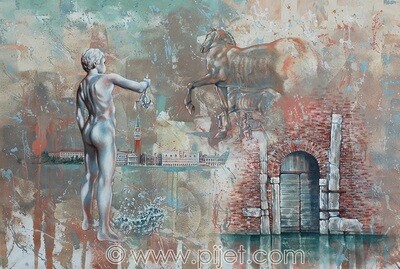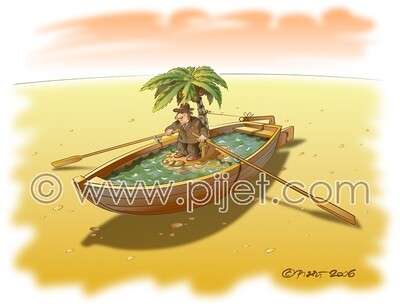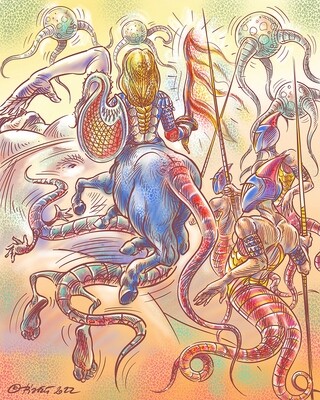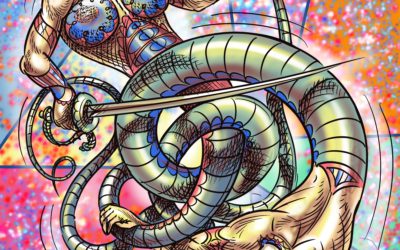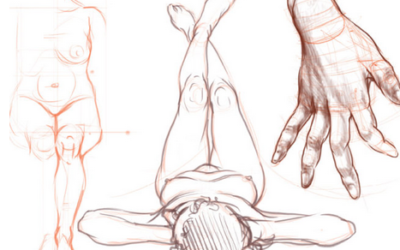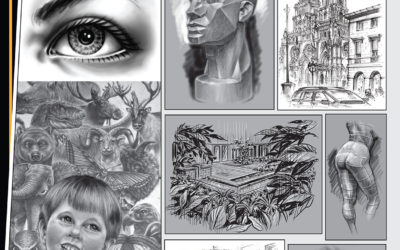Pieter Brueghel’s painting The Return from the Inn as a symbolic regard of his contemporary
The Montreal Museum of Fine Arts copy of Pieter Brueghel the Younger painting
Return from the Inn (see fig.1), or as titled in The Dictionary of Art: The Drunk Thrown
out of the Inn, is generally commented as representation of Flemish countryside in winter
with some sexually oriented symbolism. Contrary to those statements, looking closer at
this particular artwork, we can see much deeply motivated image, fulfilled with many
symbolic references to the historical events, with satirical regard of outgoing socio-
political changes in XVIth and XVIIth century Netherlands.
There are very little existing documents written about this painting. According
to existent Montreal museum information, the artwork was executed sometimes
in 1620.1 At first contact with the painting, we can feel emanating warm palette of
colors of the classical composition of XVIth and XVIIth century with central
perspective of the winter landscape, with humorous scene of walking couple with a
child. Woman is trying to pull a drunken man, probably her husband, out from further
situated fighting men in front of the Inn. The man’s clothing in disorder with visibly
_______________________________________________________________________
1 During the exposition Bruegel. Une dynastie des peintres in 1980, in Brussel. In the catalog wrongly stated information, the painting was signed P.Brveghel, what would indicate the period before 1616. This point of view was defended by written note of Mrs.Jaqueline Foli. Lately corrected in reference to the 20 last years of signatures on his works as P.Brevghel it become evident that the artwork was done after 1616. Reference taken from the book of Klaus Ertz, and Christa Nitze-Ertz. Pieter Breughel Le Jeune (1564-1637/8) The Younger-Jan Breughel L’ancien (1568-1625) The Elder une famille des peintres Flamands vers 1600. Luca Verlag Lingen et Koninklijk Museum Voor Schone Kunsten, Anvers, 1998.
erected parts of his body, suggest his state of excitement, as he was probably interrupted
by his wife, when battling with the others. He gives an impression of a desire to get
back, and fight some more. The child currying the bagpipes, probably his father’s
instrument to play, is turned back to the viewer, as a proof of his embarrassment by his
father’s condition. On the right side we can see an agitated group of men trying to resolve
their differences using physical persuasion. Looking dipper in the Inn, we see that a
women stand besides their men. Some further placed silhouettes, are exercising theirs
usual every day occupations. The composition of the houses directing the viewer to the
church situated in the far end. It could be any time of the day, however the darker sky on
the right, and lighter on the left, suggest either very early in the morning, or late
afternoon. With the humoristic lively regard at his contemporary, it is a pleasant painting
to look at. In comparison to his father’s, Pieter Breughel the Elder, work, this painting as
well as other copies of his landscapes, executed by his son, Pieter Brueghel the Younger,
doesn’t have the finesse of elaborated colors. It keeps us however in the particular for
Brueghels colorfully animated ambience of great storytellers.
In regard to the actual socio-political situation of XVIth and XVIIth century Netherlands, the picture Return from the Inn, could be seen as perfect symbolic, and satirically motivated composite of references to the actual tumultuous events of Pieter the Younger times. Before going any further, we need to look at some biographical facts of his life. There are not existing documents to prove the exact date of birth, of Pieter Brueghel the Younger. However, in notifications concerning the later periods, it is stated that his birth took place sometimes between 1564 and the beginning of 1565, in Brussels. That is almost at the outbreak of The Eighty Years War (1568-1648) 2 for Netherlands
_______________________________________________________________________
2 Other name, Dutch Revolt of 17 Provinces against the Spanish supremacy.
independence. He was the older son of three children; Pieter, Jan, and Maria, of Pieter
Brueghel the Eldest. When his father died, Pieter had 5 years. After the death of his
mother, all three children were growing up with their grandmother, Mayken Verhulst
Bessemers. She was a well established painter of watercolors and miniatures. In
consistence with existing information, it was her who initiated the two boys; Pieter, and
Jan to the painting.3 In 1578, just few months before William I of Orange united the
Northern states of Holland by the Union of Utrecht (1579), the family moved to
Antwerp.4 During 1578-1579 he was practicing painting in the atelier of Gills Van
Coninxoloo. In 1584-15855, Pieter Brueghel the Younger, became a master in the painters
corporation of Antwerp, and in 1588 he married a sister of Van Coninxoloo, Elisabeth
Goddelet, having seven children with. Pieter the Younger concentrate mostly on multiply
copies of his father’s works, very in demand at that time. He was changing time to time
some details, and composing time to time his own landscapes, always in prolongation of
Brueghel style. Some paintings he copied more than 60 times, as for example Winter
skating landscape with skaters. Accordingly to existing knowledge about his economic
performances, he never owned a house and wasn’t always paying his obligations on time.
There might be one explanation of such fact, very low prices for his work, as most
pictures were copies of already existing artworks. Pieter the Younger died in 1637, or
1638, 10 years before a complete independence of Netherlands.6 Having age of 73, 74, he
_______________________________________________________________________
3 According to The Dictionary of Art, Van Mander (his contemporary writer) suggested that Pieter the Younger receive his first training from Gilles Van Coninxloo, but in the book Breughel le jeune-Brueghel l’ancien Une famille de peintres flamands vers 1600, the same Van Mander suggest that Pieter the Younger
was introduce to the painting by his grandmother Mayken Verhulst Bessemers.
4 Antwerp joined the North in independences struggles, however after the Oath of Abjuration in 1581, when Netherlands announced their independence from Spain, Spanish sent an army and restore the order in the majority of South provinces, including Antwerp.
5 1584, year of assassination of William I of Orange leading character of the struggles for Netherlands independence
was still painting. He was representing a Flemish renaissance, living and creating during
great socio-political changes, and constant struggles for independence from Spanish
rulers. It was a time of discoveries of a New World, spreading Humanism directly from
Italy, Reformation, and growing tensions in Protestantism movements (Lutheranism,
Calvinism), and Vatican established order. Taking in consideration all this vaguely
introduced historical background, looking at the painting in different context, we see
editorial reflection of Netherlands society.
Regarding at Pieter the Youngest Return from the Inn in this new light, it is completely different picture, filled up with symbolic allusions to the Flemish reality of that time. Looking at the river dividing the landscape on two sides, where on the far end we see a church taking large part of the space, we can’t miss it, it is there, excellent symbolism of ongoing battle of the churches, The Protestant and The Roman Catholic. In other words it represents the division on left side, the North, 7 and right, the South.8 On the first plan a walking couple with a child, it is symbolic picture of Flemish family, with a child heading to the left side of the river, to the free world. Drank man with his clothing in disorder, wearing red9 jacket, with long knife10 in his hand, pulled away from a fight by
his wife, and following a child carrying bagpipes, it is perfect allusion to the exodus of
mostly protestant population, from the South provinces to the North. During the entire
military conflict for independence, in order to avoid prosecutions from the Spanish, many
6 Treaty of Munster signed in 1648, ended the war, and brought a recognition of The Dutch Republic as independent nation.
7 Group of first independent provinces, united together by Union of Utrecht in 1579.
8 Provinces expressing their loyalty to the Spanish king, and Roman Catholic Church, as a Union of Atrecht, 1579.
9 Red is a symbol of masculinity, energy, courage, vigor, love, etc. Dictionary of symbols by Wladyslaw Kopalinski, Wydawnictwo Wiedza Powszechna, 1990.
10 Knife is a symbol of fire, wind, spirit, men principles, etc. Dictionary of symbols by Wladyslaw Kopalinski, Wydawnictwo Wiedza Powszechna, 1990.
families flee the South to the North. For example, Antwerp with the population of
100. 000 in the beginning of the conflict, had only 40.000 left at the end. Further more,
following a child is a symbol of regeneration and new better life, where the bagpipes will
be played again. The musical instrument in this context refers to music, and music means
joy and relax. The man is still visibly agitated, if it wouldn’t be for the family, he will
probably still fight in front of the Inn, what suggest his face turned towards the combating
group. The enormous tree with wayside shrine on its trunk is a symbolic connection
between two sides of the river, those are the roots of the future unification as one nation.
Meanwhile, it is a sign of the border between divided societies. The wayside shrine
vandalized from the right side, with crocked cross on the roof (indicating also the right),
refers to the religious origins of the existing conflict. The white margaritas represent the
possible future coexistence of both churches. Looking on the right site of the landscape,
we see a group of battling man in front of the Inn. Symbolic reference to the conflict
between the supporters of Spanish rules and the Protestants independency movement.
The quarreling individuals wearing a red costumes, and a man between in olive green as a
symbol of peace, trying to separate the fighting parties, is an direct reference to the
necessity of negotiating a peaceful solution to the ongoing conflict. The Inn it self
represents a house in disorder, in comparison to the peaceful left site of the river (North),
where we see a man walking with the wood necessary to keep a warm comfortable house.
It symbolize the efforts of the North to bring a peace and prosperity in unification and
peaceful coexistence of all 17 Netherlands provinces. Little aside of battling individuals,
we see a still burning cinders, which symbolize a war yet in process. The eating birds,
one cock with a chicken around him, is representative image of society trying to continue
their everyday activities in the hostile neighborhood. Close to the yet alight cinders, in the
right side lower corner, we have a hollow scooped out in the tree trunk, with a wooden
beam going trough, as a representation of possible final, successful resolution to ongoing
efforts towards independence and tolerance, which will be eventually possible by
unification of the nation. Such anatomic seclusion of particular elements of this
painting, with attached symbolic meaning to it, might be seen as purely speculative.
However, Brueghel as an artist gifted with artistic sensibility, was certainly very concern
in every aspect of life, and as such, he saw a ridicule side of it as well. It wouldn’t be
exaggeration to say that most of his father’s paintings, and executed by him copies of
those, have hidden political statements concerning a multitude issues of the times they
were leaving in. That’s why such interpretation might be truthful. Pieter the Younger,
was a chronicler and critic of the tumultuous times of important changes in the
Netherlands socio-political landscape of XVIth and XVIIth century. He was a symbolic
mirror of difficult times of civil war.
For many years his work was forgotten. Pieter Brueghel the Younger was rediscover
again after 1934 exposition, organize by Pieter de Boer, merchant d’art. Interest in his is
work developed slowly. During the 1965 exposition of Flemish painting of XVII century,
where all the Brueghels were present, with the exception of Pieter the Younger. The real
interest in his painting came later, when an art merchant, Robert Fink, actually
start promoting his work to the public trough many different galleries. During the
exposition of Une dynastie des peintres in Brussels, 1980, it was a first time, when he
was exposing together with his father and brother. It was where the Montreal copy was
exposed as well. Furthermore, the full recognition was accorded to him as leading
ambassador of his father’s work, during the exposition From Brueghel to Rubens in
Vienna, Cologne, and Antwerp, in 1992. Pieter the Younger, was a chronicler and critic
of the tumultuous times of important changes in the Netherlands socio-political landscape
of XVIth and XVIIth century. He was a symbolic mirror of difficult times of civil war. It
will be exaggeration to consider him as influential artist to the others, but as a great
admirer of his father’s work, it makes him extremely important artist in preservation of
Pieter’s the Elder, heritage.
In conclusion, the Montreal copy of the painting Return from the Inn, in regard to
the characteristic central composition so particular only to the Pieter the Younger, and not
existing in any of Pieter the Elder works, it is suggested that it might be his own
composition, and not as previously thought a copy of the perished in a fire original
executed earlier (probably) by his father. As an example supporting this theory are few
compositions with the same principal centrally divided perspective as on his tondo
landscape, The Winter. One thing is sure that in comparison with his father Pieter the
Elder he was extremely precise in depicting detailed objects in his works, and as such, he
advanced his father. In the recent times his work is in demand as well as his father, and
brothers, so it is rare to have anything available on the market from any member of
Brueghel’s family.

